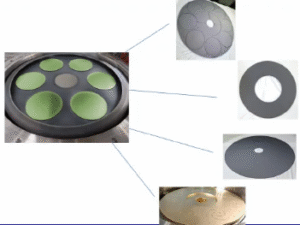
燃料電池は触媒に頼りにエネルギーを発生させる化学反応を運転します。 これらの触媒は、活性化エネルギーを低下させ、反応がより速く、より効率的に起こることを可能にします。 それらがなければ、プロセスは実用的な使用のために余りに遅くなります。 燃料電池技術の触媒は、エネルギー変換が最適速度で行われることを保証します.
要点
- 燃料電池の触媒は不可欠です、それらは有効化エネルギーを下げ、化学反応を加速するので、有効なエネルギー生産を可能にします.
- 触媒は燃料電池の性能に著しく影響を与えます;良質の触媒はエネルギー出力を最大化し、運用コストを削減します.
- 貴金属触媒の代替品を非貴金属や グラフェンのような革新的な材料、燃料電池の有用性および持続可能性を高めることを約束して下さい.
燃料電池とその主要コンポーネントは何ですか?
燃料電池の定義と機能
燃料電池は装置です 化学反応による電力を生成. . 電池とは異なり、エネルギーを蓄えませんが、燃料や酸化剤が供給される限り継続的に生産します。 化学エネルギーを燃焼せずに電気エネルギーに変える小さな発電所として考えられます。 このプロセスは、効率的かつ環境に優しいものにします。 動力を与えられた車から建物のための電気を提供するために燃料電池はさまざまな適用で、使用されます.
コアコンポーネントとその役割
燃料電池はエネルギー生産の重要な役割を担っている複数の主要なコンポーネントから成り、それぞれ成っています。 ザ・オブ・ザ・ アノード 水素などの燃料が入ると反応する場所です。 ザ・オブ・ザ・ カネホデ 酸素が水素イオンとの反応に入り、容易にすることを可能にします。 これらの2つの間には、 電解液電子をブロックしながらイオンを伝導する。 ザ・オブ・ザ・ 触媒層 陽極および陰極の反作用を加速し、有効なエネルギー転換を保障します。 最後に、 バイポーラプレート ガスを分配し、生成された電気を収集します。 各部品は、シームレスなエネルギー生産プロセスを作成するために一緒に働きます.
エネルギー転換の化学反応
水素燃料電池では、陽極で化学反応が始まります。 水素分子は、プロトンと電子に分割され、 燃料電池の反応のための触媒. . 陽子は電解物を通過し、電子は外部回路を通過し、電気を発生させます。 陰極では、酸素はプロトンと電子を結合し、副産物として水を形成します。 この反応は、電気、熱、水だけを生成し、清潔で効率的です.
燃料電池の触媒:役割との重要性
触媒が反応を加速する方法
触媒は、燃料電池内の化学反応をスピードアップする際に重要な役割を果たしています。 これらの反応に必要な活性化エネルギーを低下させることで働きます。 これは、関与する分子がより簡単かつ迅速に反応することができることを意味します。 例えば、 水素燃料電池触媒は、水素分子を陽子および陽極の電子に分解するのに役立ちます。 陰極では、酸素と水素イオンの反応を促進し、水を形成します。 触媒がなければ、これらのプロセスは、実用的な使用のための燃料電池の非効率性を作る大いに長くかかります.
燃料電池の効率および性能への影響
燃料電池の効率性は、触媒の性能に大きく依存します。 ツイート 高品質の触媒 化学反応が最適な速度で発生し、エネルギー出力の最大化を保証します。 また、工程中のエネルギー損失を最小限に抑えます。 燃料電池技術の触媒により、システム全体の性能が向上します。 つまり、同じ燃料からより多くのエネルギーを得ることができます。 また、耐久性と寿命をさらに高める燃料電池の動作温度を抑えるのに良い触媒が役立ちます.
燃料電池における触媒反応例
典型的な水素燃料電池では、2つの主要な反応は触媒に依存します。 アノードでは、触媒は水素(H2)をプロトン(H+)と電子(e-)に分割します。 電力の発生に欠かせない反応です。 陰極では、別の触媒は副トンおよび電子と結合し、副産物として水(H2O)を作り出します酸素(O2)を可能にします。 これらの反応は、触媒が燃料電池でエネルギー変換を可能にする方法を強調しています。 これらのプロセスを加速することにより、燃料電池システムの触媒は、クリーンで効率的なエネルギー生産を保証します.
触媒とその応用の種類
貴金属触媒(プラチナなど)
プラチナのような貴金属は最も多くあります 燃料電池の有効な触媒. . 水素燃料電池では、アノードとカソードの両方で反応速度を上げることで、一般的に使用されるプラチナが見られます。 それはプロトンおよび電子に水素の分子を分け、水を形作るために水素イオンとの酸素の組合せを促進し。 プラチナの高効率と安定性は、最高の選択です。 しかし、その費用と限られた可用性は、課題をポーズします。 研究者は、必要に応じてプラチナの量を減らすか、代替品と交換するために働いています.
非貴金属および新興代替品
鉄、コバルト、ニッケルなどの非貴金属は、より手頃な価格のオプションを提供します。 これらの材料は燃料電池の触媒として機能できますが、それらは頻繁に性能を改善するために付加的な処置を要求します。 これらの金属は窒素または炭素と組み合わせて触媒特性を高めることができます。 金属組織の枠組み(MOF)や単原子触媒などの代替品も注目されています。 これらの革新は費用効果が大きい、有効な解決をのための提供することを目指しています 燃料電池の技術.
グラファイト及びその他の革新的な材料
グラファイトや炭素系材料は、燃料電池触媒において成長する役割を果たしています。 グラファイトは軽量、導電性、耐腐食性があり、優れた支持材料であることに気づくでしょう。 研究者は、独自の特性のためにグラフェンとカーボンナノチューブを探索しています。 これらの材料は、コストを削減しながら、触媒の機能、耐久性と性能を向上させる方法に革命をもたらすことができます.
燃料電池における触媒サポートとその役割
Catalystサポートの定義と目的
Catalystは安定したサポートを提供します 燃料電池の触媒の基礎。 触媒パーティクルを所定の位置に保持し、均等に配布されるようにします。 この構造は、化学反応のために利用可能な表面面積を最大化します。 サポートがなければ、触媒は、その有効性を削減し、一緒に塊状になる可能性があります。 正しい位置にあるすべてのものを最適なパフォーマンスに保つ、カタリストが足場としてサポートしていると考えることができます.
触媒は、システムの全体的な耐久性を向上させるもサポートします。 触媒が急速に劣化しないようにすることで、燃料電池の寿命を延ばすことができます.
触媒の耐久性および性能を高めて下さい
耐久性と性能を両立させる上で、触媒が果たす役割を担っていることに気づくでしょう。 高温や腐食性環境などの過酷な動作条件から触媒を保護します。 また、燃料や酸化剤との相互作用を確実にすることで触媒の効率性を向上させることができます。 つまり、燃料電池は、エネルギーをより一貫して時間をかけて生産することができます.
共通のサポート材料および革新
複数の材料は触媒サポートとして役立つ。 グラファイトやカーボンブラックなどのカーボンベースの素材は、導電性や軽量性により人気があります。 二酸化チタンなどの金属酸化物は、優れた安定性を提供します。 グラフェンやカーボンナノチューブなどの革新的な材料を研究しています。 これらの高度サポートは燃料電池の技術に革命を起こすことができます 触媒の性能を改善する コストを削減しながら燃料電池システム用.
触媒技術の挑戦と進歩
貴金属のコストとサステナビリティ
プラチナのような貴金属は触媒として非常に有効であるが、重要な課題を伴います。 高価なコストで燃料電池を高価に生産します。 限られた可用性は、これらの金属を採掘し、精製することによって、環境に影響を与える問題に追加します。 代替品がまだ広く使用されていない理由は不思議かもしれません。 その理由は、貴金属の比類のない効率性と安定性にあります。 しかし、研究者は燃料電池のプラチナの量を減らす方法を模索しています。 リサイクル触媒は、他の有望なアプローチです。 古い燃料電池から貴金属を回収することにより、コストを削減し、環境害を削減することができます.
耐久性と劣化への対応
耐久性は燃料電池の性能の重要な要因です。 時間が経つにつれて、過酷な動作条件で触媒が劣化します。 高温、湿気および化学反応は触媒を弱めることができます。 燃料電池の効率を低下させます。 そのためには、科学者たちはより堅牢な材料を開発しています。 保護層が付いているコーティング触媒は低下を遅らせることができます。 また、グラフェンのような先進的な支持材料が、耐久性を高めます。 これらの革新は燃料電池システムのための触媒が長続き、信頼性を改善し、維持を減らすことを保障します.
触媒設計・材料のイノベーション
触媒技術の進歩 燃料電池を変形させます。 単原子触媒は1つの刺激的な開発です。 これらの触媒は、材料の使用を最小限に抑えながら、個々の金属原子を使用して、効率を最大化します。 金属組織のフレームワーク(MOFs)は、別の画期的なものです。 有機化合物と金属を組み合わせ、多孔質な構造を生み出します。 この設計は反応のための表面区域を高めます。 また、貴金属を完全に交換することを目的として、非金属触媒の進歩も見られます。 これらのイノベーションは、燃料電池をより手頃な価格で持続可能なものにし、より広い採用のための方法を残すことを約束します.
触媒は燃料電池の効率を運転し、クリーンなエネルギー生産を可能にします。 コストや耐久性などの課題に取り組む材料やデザインに強みがあります。 イノベーションを支える役割を担っています。 技術が進化するにつれて、触媒は 燃料電池システム 持続可能な未来への道を切り、エネルギーが世界に与える影響を変革します.
よくあるご質問
燃料電池で最も一般的な触媒を作ることは?
反応をスピードアップし、劣化に抵抗するプラチナショベル。 その比類のない効率性と安定性は、高コストにもかかわらず、水素燃料電池のトップ選択肢となります.
燃料電池は触媒なしで働きますか?
いいえ、できません. 活性化エネルギーを低下させる触媒反応が素早く起こるようにします。 燃料電池を使わずに、使いやすさを生み出すために、燃料電池はゆっくりと作動します.
プラチナ触媒に手頃な価格の選択肢はありますか?
お問い合わせ 鉄やコバルトなどの非貴金属、およびグラフェンや金属組織のフレームワーク(MOF)などの革新的な材料、燃料電池触媒の費用対効果の高いオプションを提供します.
ログイン チップ: 代替触媒への支援研究は、燃料電池をより使いやすく、持続可能なものにするのに役立ちます.






